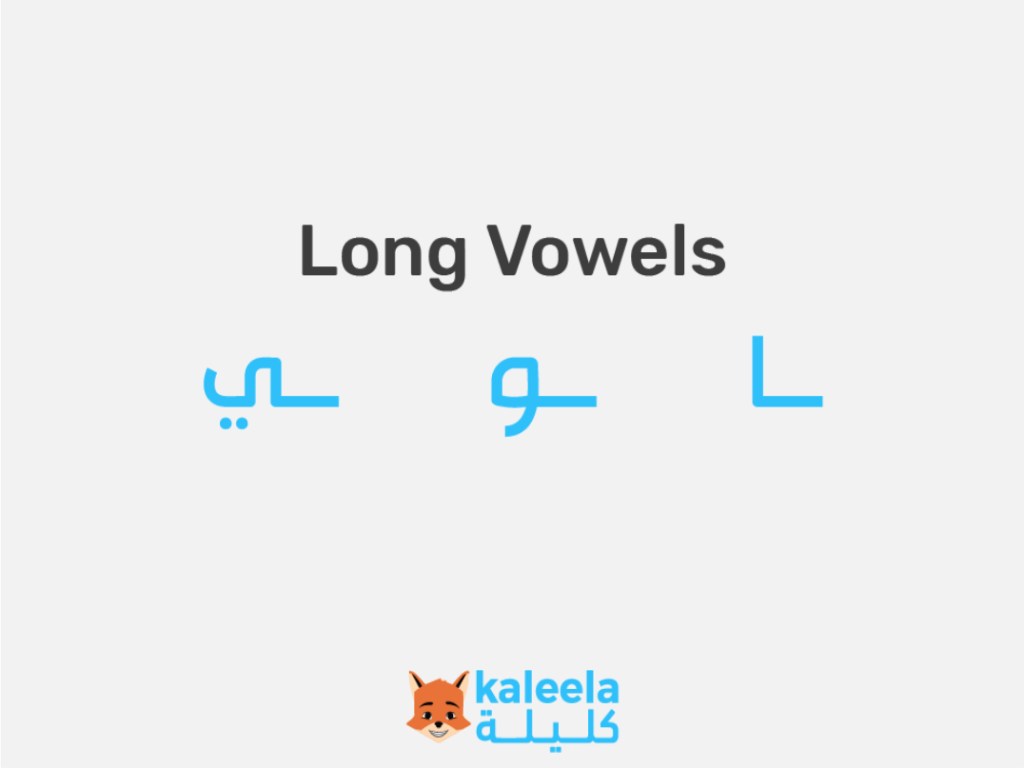Embarking on your Arabic language journey? Then grasping Arabic vowels is a fundamental step! Unlike English, Arabic has both short and long vowels, each playing a crucial role in pronunciation and meaning. This guide will clearly explain these vowel sounds and introduce you to the important letters alif, waw, ya, helping you build a solid foundation for reading and speaking Arabic.
The Foundation: Short Vowels in Arabic
As we learned previously, short vowels in Arabic are indicated by harakat (vowel marks) placed above or below consonants. These give a quick, fleeting sound to the letter they accompany. The three main short vowels are:
- Fatha – فَتْحَة : Represented by a small diagonal line above the letter ( َ ), producing a short “a” sound like in “cat”.
- Example: كَ (ka) – the first sound in كِتَاب (kitaab – book)
- Kasra – كَسْرَة : Shown as a small diagonal line below the letter ( ِ ), creating a short “i” sound similar to “bit”.
- Example: كِ (ki) – the first sound in كِلْب (kalb – dog)
- Damma – ضَمَّة : Depicted as a small curl above the letter ( ُ ), resulting in a short “u” sound like in “put”.
- Example: كُ (ku) – the first sound in كُرْسِيّ (kursiyy – chair)
These short vowels are essential for forming words and understanding their basic sounds.
Extending the Sound: Long Vowels in Arabic
Arabic also features long vowel sounds, which are held for a longer duration than the short vowels. These long vowels are typically represented by three specific letters: أَلِف (Alif), وَاو (Waw), and يَاء (Ya). This is where the phrase “alif waw ya” becomes significant.
These letters act as vowel extenders when they follow a consonant that already has a corresponding short vowel:
- Long “aa” (آ / ـَا): This long vowel sound, similar to the “a” in “father” or “car,” is usually represented by an أَلِف (Alif) preceded by a consonant with a فَتْحَة (Fatha).
- Example: بَا (baa) – as in the word بَاب (baab – door). Notice the بَ (ba) followed by ا (alif).
- Long “oo” (ـُو / وּ): This long vowel sound, like the “oo” in “moon” or “boot,” is typically represented by a وَاو (Waw) preceded by a consonant with a ضَمَّة (Damma).
- Example: بُو (boo) – as in the word بُوم (boom – owl). Notice the بُ (bu) followed by و (waw).
- Long “ee” (ـِي / يـ): This long vowel sound, similar to the “ee” in “see” or “meet,” is usually represented by a يَاء (Ya) preceded by a consonant with a كَسْرَة (Kasra).
- Example: بِي (bee) – as in the word بَيْتِي (baytee – my house). Notice the بِ (bi) followed by ي (ya).
The Significance of Alif, Waw, Ya
So, what is the alif, waw meaning in the context of vowels? These three letters are not just consonants; they are the key indicators of long vowel sounds in Arabic. Recognizing alif, waw, ya and the short vowels that often precede them is crucial for accurate pronunciation and distinguishing between words.
Think of it this way:
- The fatha (short “a”) loves to stretch out with an alif to become a long “aa”.
- The damma (short “u”) enjoys lingering with a waw to become a long “oo”.
- The kasra (short “i”) likes to extend its sound with a ya to become a long “ee”.
Short and Long Vowels in Arabic: A Comparison
To solidify your understanding, let’s compare short and long vowels in Arabic:
| Vowel Sound | Short Vowel (Harakat) | Long Vowel (Letter) | Example (Transliteration) | Arabic Word | Meaning |
|---|---|---|---|---|---|
| “a” | فَتْحَة (fatha) | أَلِف (alif) | kataba | كَتَبَ | He wrote |
| “aa” | فَتْحَة + أَلِف | أَلِف (alif) | kaatib | كَاتِب | Writer |
| “i” | كَسْرَة (kasra) | يَاء (ya) | samia | سَمِعَ | He heard |
| “ee” | كَسْرَة + يَاء | يَاء (ya) | samee’ | سَمِيع | Hearer |
| “u” | ضَمَّة (damma) | وَاو (waw) | kataba (different form) | كُتِبَ | It was written |
| “oo” | ضَمَّة + وَاو | وَاو (waw) | kutub | كُتُب | Books |
Mastering Arabic Vowels: Your Path to Clear Pronunciation
Understanding the difference between short and long vowels in Arabic, and recognizing the role of alif, waw, ya, is a significant step towards fluent Arabic. Pay close attention to these vowel sounds as you learn new words and practice your pronunciation. With consistent effort, you’ll be able to distinguish between subtle sounds and communicate more effectively in Arabic.
Ready to delve deeper into the nuances of Arabic pronunciation? Visit www.kaleela.com for comprehensive lessons and interactive exercises designed to make learning Arabic engaging and effective. Download the Kaleela app today and start mastering the sounds of Arabic!



